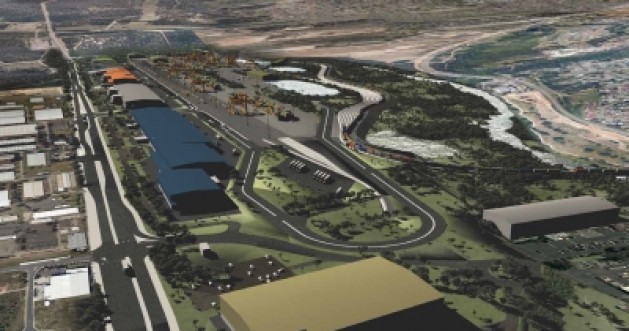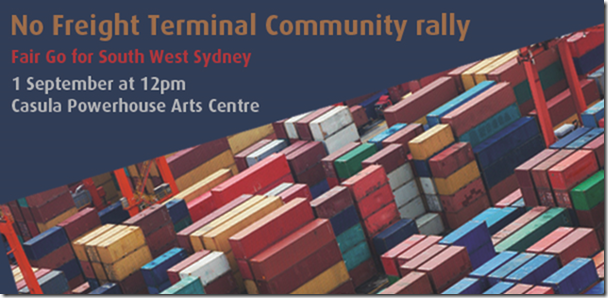MOOREBANK INTERMODALS
Key assumptions require deeper scrutiny.

At Moorebank in South Western Sydney, two massive intermodal terminals are being planned. One proponent is a private consortium and one is the federal government. Together these two developments could generate more traffic than travels daily over Sydney Harbour Bridge.
They are tragically ill-suited to the location, yet somehow the fundamental assumption that this is a suitable location for intermodals has never been properly interrogated. Thousands of pages of consultants’ reports have been written and billions of dollars have been spent without ever querying whether it is a rational decision.
This book seeks to redress that deficiency. It is the product of extensive research and took over a year to research and write. Each page explains a different facet of the proposals. It is simply written and easy to read, but delivers hard-hitting information.
It is shown that this major infrastructure is being delivered on flawed assumptions.
Sources
The sources for most of the figures in this publication are current government studies, plans, and statistical data. References are given throughout.
Additional calculations and modelling, where required, were conducted using international industry standard softwares and methods.
The book shows:
-
That not one, but two intermodals are proposed for Moorebank. One proponent is a private consortium and the other is the Federal Government. Together they could potentially produce more traffic than that which travels daily over the Sydney Harbour Bridge. (Using one truck equals two passenger cars units.)
-
That traffic flows from the intermodals have been grossly underestimated. We observe that the developer’s figures do not include a massive predicted population growth.
-
That intermodals in Moorebank could not be functional without extensive city-wide infrastructure investment. Particular challenges of geography and road access are identified. We note that 27% of the traffic from the intermodals will be forced to use the Hume Highway. It will pass through the worst accident black spot in Sydney.
-
That exaggerated claims of reduced truck movements and economic benefits have been promoted to the public. That economic information has been hidden from the public.
-
How the traffic implications of intermodals in Moorebank have not been sufficiently studied. This includes the implications of induced traffic, warehousing, rat running and levels of service.
-
How placing the intermodals in Moorebank may possibly lock Liverpool into low employment density industries, which will make it more difficult to meet the expected jobs shortfall of 150,000.
-
That jobs from an intermodal and warehousing come with many times more trucks than other kinds of jobs.
-
How the intemodals may carry a huge cost into the future through increased cancers, asthmas, injury management and other health costs.
-
That disbenefits to the community do not appear to have been properly studied, and how the community may underwrite a large profit for investors by paying for these costly disbenefits.
-
How pollution modelling based on the traffic estimates has been grossly underestimated and does not reflect population growth. That diesel exhaust contains 100 to 1000 times more carcinogens than exhaust from petrol. That Liverpool’s pollution readings have exceeded recommended limits for 9 out of the last 10 years.
-
That the intermodals would impinge on residential areas and impair access to the Liverpool CBD and the recently upgraded hospital.
-
That placing the intermodals at Moorebank would counteract efforts to improve the health of the Georges River. How there are endangered ecological communities and threatened species on the sites.
-
That the intermodals would diminish the Casula Powerhouse Art Centre and Georges River Casula Parklands.
-
That there appear to be more appropriate, more efficient, more economical solutions for an intermodal, including Eastern Creek and Port Kembla and the Maldon-Dombarton rail link.
Two links to popular Anti Moorebank Intermodal Websites.
Link to the “Moorebankterminal“ website for additional information: http://www.moorebankterminal.com/
Link to the “Moorebankintermodal” website: http://www.moorebankintermodal.com
Previous Liverpool City Council No Freight Terminal Community Rally
 Link for Liverpool Council website – information regarding rally 1 September at the Casula Powerhouse and petition to sign http://www.liverpool.nsw.gov.au/fairgo
Link for Liverpool Council website – information regarding rally 1 September at the Casula Powerhouse and petition to sign http://www.liverpool.nsw.gov.au/fairgo
Link to Letter Box Drop Brochure here: DL_Brochure_V6LR
Link to Document submitted to the SIMTA Environmental Impact Statement submitted by Nell van den Bos: Comment on SIMTA EIS
Link to the Environmental Impact Statement (EIS) : http://simta.com.au/environmental-impact-assessment/


Comment on today’s (27th May 2014) Moorebank intermodal terminal announcement.
Moorebank’s proposed intermodal terminal will have IMEX capacity of 1.2 million teu per year because that is the maximum available rail capacity from Port Botany after servicing the existing terminals at Minto, Yennora and Enfield.
Both the NSW and Australian Governments decline to reveal the total capacity of the Port Botany rail freight line, which is managed by Australian Rail Track Corporation. However, the NSW Government is continuing to claim that there will be a ”significant increase” in the proportion of containers carried by rail. At present, 0.3 million teu, or 15 per cent, of Port Botany containers are carried by rail, the rest by truck.
It is unknown what the ”significant increase” in rail will amount to.
The intermodal terminals at Minto, Yennora and Enfield have combined capacity of 0.6 million teu. This suggests that the capacity of the Port Botany rail freight line is 1.8 million teu.
In 2030, Port Botany’s throughput is expected to reach 7 million teu. If the rail freight line’s capacity is 1.8 million teu, the proportion railed will be 26 per cent. At any time the NSW and Australian Governments are available to clarify the capacity of the Port Botany rail freight line.
In 2030, the number of container truck movements between Port Botany and western Sydney will increase to 2.6 million from 0.85 million now. A container truck using the M5East westbound tunnel is the equivalent of six passenger cars. 2.6 million container trucks will require about 25% of the tunnel’s capacity.
Eighty per cent of containers railed to Moorebank will be trucked to the final destination. On average, a container-carrying truck serving MIC’s proposed facility will carry 1.7 teu. The Moorebank intermodal terminal will add 564,000 truck movements a year to local roads, excluding interstate transfers.
Moorebank does not have adequate road capacity.
Servicing Moorebank from Port Botany by rail will require investment in rail and road infrastructure of $7 billion.
Building stages 2 and 3 of the Northern Sydney Freight corridor by 2028 will cost $4.4 billion (in present value terms). Building the Western Sydney Freight Line to Eastern Creek will cost around $1 billion. Building the Maldon-Dombarton rail line will cost around $600 million (the line is needed for Port Kembla after Port Botany reaches capacity). Connecting Port Botany to WestConnex for container trucks will cost around $1 billion.
Who is paying $7 billion to maintain container terminal operations at Port Botany?
If the $7 billion investment is not made, what will be the increase in road freight transport in Sydney?
Greg Cameron
The Trouble with Moorebank;
Long-time intermodal campaigner Greg Cameron says the plans for Moorebank are flawed as rail capacity is not sufficient to meet planned demand.
Under current NSW policy, Mr Cameron says, 98% of all containers will be trucked by 2030. At least 74% will be trucked through Port Botany and 24% will be trucked after being railed to an intermodal terminal.
Link for full story:
http://www.tandlnews.com.au/2013/12/12/article/the-trouble-with-moorebank/
Update: Channel 9 “A Current Affair” program had this to say about the proposed Intermodals. Several residents, the Mayor and Councillor provided input for the program.
http://aca.ninemsn.com.au/article/8729085/industrial-mega-hub-is-backyard-disaster
Hi everyone,
Please see below comments that were recently made to the Liverpool Leader which they published this week. This is an important issue and we thought we would also circulate this just in case you missed it. I have also discovered some people that I know were also under the impression that the current building along Anzac Road is the beginnings of the intermodals.
I have had a number of people mention to me that the construction of the Moorebank Intermodal is well underway. When questioned they all indicate the construction that is taking place in Anzac Road. People need to know that the construction taking place in Anzac Road is in fact the new premises for the Defence National Distribution Centre that they will move into from their currently leased facility on the eastern side of Moorebank once completed.
It also needs to be noted that neither of the two proposal to build Freight Terminals at Moorebank have been officially approved and as such it is not yet a done deal.
Allan
I was extremely distressed to read in the Liverpool Leader page 3 July10 2013. The Intermodals will
• Reduce heavy vehicle movements between Port Botany and Moorebank by up to 2700 movements per day.
• Positive impact on air quality by reducing the number of truck movements
• Reduce emissions by up to 40 000 tones of CO2 yearly – an equivalent to more than 10 000 cars off Sydney roads.
This is the same deceptive propaganda that lead to the production of the book I have taken 12 months out of my life to write. This book ‘Moorebank Intermodals Key Assumptions Require Deeper Scrutiny’ dispels these misconceptions that are being spread by the proponents of the Moorebank Intermodals. We call for serious studies to be carried out not hearsay or flawed scientific research. Please listen to what the book is telling you. These conclusions above are not correct. I have tried to explain with as little understanding required as I possibly can to try to help you to understand the scientific basis for my claims and yet the old stuff is being regurgitated. Please take the time to read the book and assess for yourself. Yes the issues are complex. Far more complex than the book I have written but please see that you are being lead to believe flawed information.
I know you are busy but this will affect tens of thousands of people so I would appreciate you taking the time to reply to my comment.
(This is a copy of the e-letter sent to all those on the mailing list.) Admin.
I wish to thank the LCIT for their efforts regarding the Moorebank Intermodals and their book and their e letter is a much valuable move. I have done enormous research on the matter and believe that the proponents SIMTA and the Federal government are hiding the real impact on the community, I have great concerns for our children, our environment, our wildlife and believe it would be impossible to survive what they are planning for the area. John Anderson Wattle Grove
A letter box drop brochure is being developed by LCIT members outlining the key points raised in the book. Initially the brochures will be distributed in Moorebank, Wattle Grove, Hammondville and Holsworthy. We intend to make this a multi-language brochure to raise community awareness.
A copy of the proposed brochure is available on this website for viewing and comments.